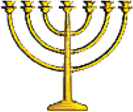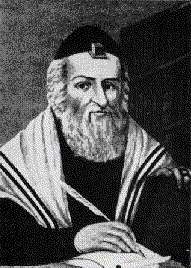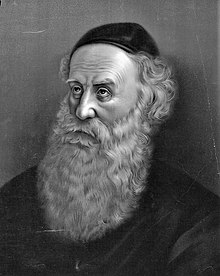This is an old revision of this page, as edited by Shlomke (talk | contribs) at 02:07, 22 June 2006 (→Hasidim and Mitnagdim: not just "alleged" by lubavitch, its a well known fact outside too). The present address (URL) is a permanent link to this revision, which may differ significantly from the current revision.
Revision as of 02:07, 22 June 2006 by Shlomke (talk | contribs) (→Hasidim and Mitnagdim: not just "alleged" by lubavitch, its a well known fact outside too)(diff) ← Previous revision | Latest revision (diff) | Newer revision → (diff)Below are descriptions of known schisms among the Jews:
First Temple era
Based on the historical narrative in the Bible and archeology, Levantine civilization at the time of Solomon's Temple was prone to idol worship, astrology, worship of reigning kings, and paganism. (Some of the divinities or idols worshipped included Ba'al and possibly Asherah.) This was in direct contrast to the teachings in the Torah, and was condemned by the ancient Biblical prophets who attacked those Israelites and Judeans who became idol worshipers. The split by the Kingdom of Israel from the Kingdom of Judah was completed by Jeraboam who crowned himself king, and built a northern temple with calf-like idol images that were condemned by the Judeans of Judah. After the destruction and exile of the northern Kingdom of Israel by Assyria, the temptations to follow non-Judaic practices continued, so that according to the narratives of Jeremiah and others, it brought about the failure, destruction, and exile of the southern Kingdom of Judah by Babylonia. Nebuchadnezzar had additional reasons for taking over Judah and turning its inhabitants into exiles, including challenging its great rival Egypt.
Second Temple era

This was a time when the Jews lived under Persian, Greek, and Roman power and influence. The main internal struggles during this era were between the Pharisees and the Sadducees, as well as the Essenes and Zealots. The Pharisees wanted to maintain the authority and traditions of classical Torah teachings and began the early teachings of the Mishna, maintaining the authority of the Sanhedrin, the supreme Jewish court. The Sadducees sought to adapt to more Hellenistic ideas, as espoused by Philo of Egypt. The Essenes preached a reclusive way of life. The Zealots advocated armed rebellion against any foreign power such as Rome. All were at violent logger-heads with each other, leading to the confusion and disunity that ended with the destruction of the Second Temple and the sacking of Jerusalem by Rome.
Break-offs: Samaritans and Christians
One small sect of Samaritans is still extant; however, their religion is not the same as rabbinic Judaism. The Samaritan faith and that of other Jews diverged over a millennium ago; they commonly refer to themselves as Samaritan Israelites as opposed to Jewish Israelites. This is because they believe they are of the northern Israelite tribes.
Of course, the most famous schism in Jewish history was the split between the followers of Jesus (who were known as Notzrim or Nazarenes) with the claim by his disciples that he was the long-awaited Jewish Messiah, and the majority Pharisees (the rabbinically led Jews) who rejected this claim. The Samaritans, on the other hand, largely became Christians, as they are depicted in the Talmud.
The abandonment of Jewish law by Jesus' followers and their promotion of him as a deity, along with the publication of the New Testament, ensured that Christianity and Judaism would become completely different and often conflicting religions. The New Testament depicts the Saducees and Pharisees as Jesus' opponents, whereas the Jewish perspective has the Pharisees as the justified followers of the rabbis who upheld the Torah, or what Christians refer to as the "Old Testament" as a mark of their having supplanted the Jews' position. This is known as Supersessionism, and is strongly rejected by Jews and Judaism. Recently, some Christian churches have rejected or softened their teachings on supersessionism.
Karaite Judaism
Main article: Karaite JudaismKaraite Judaism is a Jewish denomination characterized by reliance on the Tanakh as the sole scripture and rejection of the Oral Law (the Mishnah and Talmud). Karaites had a wide following between the 9th and 12th centuries, (they claim that at one time they numbered perhaps 40 percent of Jewry), but over the centuries their numbers have dwindled drastically. Today they are a small group, living mostly in Israel; estimates of the number of Israeli Karaites range from as low as 10,000 to as high as 40,000 .
There is a divergence of views about the historical origins of Karaite Judaism. Most scholars and some Karaites maintain that it was founded at least in part by Anan ben David, whereas other Karaites believe that they are not the historical disciples of Anan ben David at all, and point out that many of their later sages (such as Ya'acov Al-Kirkisani) argued that most of Anan's teachings were "derived from Rabbanite Lore".
The state of Israel, along with its Chief Rabbinate, ruled that Karaites are Jews, and while critical differences between Orthodox Judaism and Karaite Judaism exist, American Orthodox rabbis ruled that Karaism is much closer to Orthodoxy than the Conservative and Reform movements, which may ease issues of formal conversion.
Sabbatians and Frankists
Main article: ]In 1648 Shabtai Tzvi declared himself to be the long-awaited Jewish Messiah whilst living in the Ottoman Empire. Vast numbers of Jews believed him; but when under pain of a death sentence in front of the Turkish sultan Mehmed IV he became an apostate to Judaism by becoming a Muslim, his movement crumbled. Nevertheless, for centuries, small groups of Jews believed in him, and the rabbis were always on guard against any manifestations of this schism, always suspicious of hidden "Shebselach" (Yiddish for "little Sabbatians," a play on the word for "young dumb sheep"). Indeed, when the movement of Hasidism began attracting many followers, the rabbis were once again suspicious that this was Sabbatianism in different garb. It would take many centuries to sort out these complex divisions and schisms and see where they were headed.
After his mysterious death somewhere in the area of Turkish Albania, groups of Jews continued to be clandestine followers of Shabtai Tzvi even though they had outwardly converted to Islam, these Jews being known as the Donmeh. Jewish converts to Islam were, at times, therefore regarded with great suspicion by their fellow Muslims.
A few decades after Shabtai's death, a man by the name of Jacob Frank claiming mystical powers preached that he was Shabtai Tzvi's successor. He attracted a following, preached against the Talmud, advocated a form of licentious worship, and was condemned by the rabbis at the time. When confronted by the Polish authorities, he converted to Catholicism in 1759 in the presence of King Augustus III of Poland, together with groups of his Jewish followers, known as "Frankists". To the alarm of his opponents, he was received by reigning European monarchs who were anxious to see their Jewish subjects abandon Judaism and apostacise. The Frankists eventually joined the Polish nobility and gentry.
Hasidim and Mitnagdim
Main article: ]- Note: While the name "Hasidim" has gained popular and positive approval, the name "Mitnagdim" has fallen out of popular usage and may even be regarded as offensive by some.
The arrival of Rabbi Israel ben Eliezer (1698-1760), known as the Baal Shem Tov ("Master Good Name"), on the scene of Jewish history in Eastern Europe would herald the commencement of a sea-change in what is known today as Haredi Judaism. Even though he did not write books, he succeeded in gaining powerful disciples to his teachings that were based on the earlier expositions of Rabbi Isaac Luria (1534-1572) known as the Ari who had based much of his Kabbalistic teachings on the Zohar. The Baal Shem Tov came at a time when the Jewish masses of Eastern Europe were reeling in bewilderment and disappointment engendered by the two notorious Jewish false messiahs Sabbatai Zevi (1626-1676) and Jacob Frank (1726-1791) in particular.
The Baal Shem Tov witnessed Frank's public apostasy (shmad in Hebrew) to Christianity, which compounded Zevi's earlier apostasy to Islam. The Baal Shem Tov was thus determined to encourage his influential disciples to launch a spiritual revolution in Jewish life in order to reinvogorate the Jewish masses' connections with Torah Judaism and to vigorously motivate them to bind themselves to the joyous observance of the commandments, worship, Torah study, and sincere belief in God, so that the lures of Christianity and Islam, and the appeal of the rising secular Enlightenment, to the Jewish masses would be weakened and halted. To a large degree the Baal Shem Tov succeeded in Eastern Europe.
Already during his lifetime, and gaining momentum following his death, the Baal Shem Tov's disciples spread out to teach his mystical creeds all over Eastern Europe. Thus was born Hasidic Judaism (Hasidism). Some of the main movements were in: Russia which saw the rise of the Chabad-Lubavitch movement; Poland which had the Gerrer Hasidim; Galicia had Bobov; Hungary had Satmar Hasidim; and Ukraine had the Breslovers, and many others that grew rapidly gaining literally millions of adherents, until it became the dominant brand of Judaism in the century following the Baal Shem Tov's death. The Jewish masses flocked to this new inspired brand of mystical Judaism, and retained their connections to their Jewish heritage and way of life.

Only when this new religious movement reached Lithuania did it meet its stiffest resistance among the Lithuanian Jews (also known as Litvaks). It was Rabbi Eliyahu Kramer (1720-1797), known as the Vilna Gaon ("Genius Vilna"), and those who followed his classic stringent Talmudic and Halakhic scholastism, who put up the fiercest resistance to the Hasidim ("Righteous "). They were called Mitnagdim, meaning " oppose/d ".
The Vilna Gaon, who was himself steeped in both Talmudic and Kabbalistic wisdom, analyzed the theological underpinnings of this new "Hasidism" and in his view, concluded that it was deeply flawed since it had elements of what may be roughly termed as panentheism and perhaps even outright pantheism, dangerous aspirations for bringing the Jewish Messiah that could easily be twisted in unpredictable directions for Jewry as had previously happened with the Zevi and Frank religious "revival" fiascos, and an array of complex rejections of their religious ideology. The Vilna Gaon's views were later formulated by his chief disciple Rabbi Chaim Volozhin (1741-1821) in his work Nefesh HaChaim. The new Hasidic leaders countered with their own religious counter-arguments, some of which can be found in the Tanya of Chabad-Lubavitch. Much of the debate remains obscure.

However, regardless of the unpopularity of the move, the Vilna Gaon and the scholars of the Beth din (" religious court") of Vilna went so far as to place at least one severe cherem upon the Hasidim, officially "excommunicating" them from Judaism, which they in turn copied and did likewise to the mitnagdim. The Vilna Gaon's strongest opposition was to the founder of Chabad-Lubavitch, Rabbi Shneur Zalman of Liadi (1745-1812) and to the founder of Breslov Rabbi Nachman of Breslov (1772-1810). Physical fights broke out in Vilna with each side trying to gain the favor of the Russian authorities and declaring the other side to be beyond the pale of Judaism.
The Mitnagdim played a role in the imprisonment of the first chabad rebbe, Rabbi Shneur Zalman of Liadi, and the followers of the Vilna Gaon believed that it was the Hasidim who conspired to have their leader arrested and imprisoned. The bitterness and animosity ran deep, and basically whoever joined one wing, did not attend or pray in the same synagogues as the other wing, nor have the same Torah teachers, and they would generally not marry into each other's families, which is still more or less the rule today where there is a high degree of internal communal structure.
The split between Hasidim and Mitnagdim remains within the modern Haredi world. Only when confronted by mutual threats, such as from the secular Jews of the haskalah, or by the onslaught of Communism and the Holocaust, or faced by secular Zionists, did Hasidim and Mitnagdim put their quarrels aside, but as soon as the outside world does not threaten them, their battle of ideas resumes. Each group has its own unique method of yeshiva study and communal life, no matter where they establsih themselves. They tend to live in different neighborhoods that are still within commuting distance.
In modern-day Israel Hasidim support the Agudat Israel party in the Knesset (Israel's parliament) and the non-Hasidic Mitnagdim support the Degel HaTorah party. Degel HaTorah is led by Rabbi Yosef Shalom Eliashiv in Jerusalem. There is also another large community that follows the rabbinical teachings of the Edah Charedis. These include the Satmar Hasidim and the perushim communities which do not support any groups that participate in the Israeli government or in Israeli including elections.
Orthodox versus Reform, East versus West
Main article: Relationships between Jewish religious movementsFrom the time of the French Revolution of 1789, and the growth of Liberalism, added to the political and personal freedoms granted by Napoleon to the Jews of Europe, many Jews chose to abandon the foreboding and isolating ghettos and enter into general society. This influenced the internal conflicts about religion, culture, and politics of the Jews to this day.
Some Jews in Western Europe, and many Jews in America, joined the religiously liberal new Reform Judaism movement, which drew inspiration from the writings of modernist thinkers like Moses Mendelson. They coined the name "Orthodox" to describe those who opposed the "Reform". They were criticized by the Orthodox Judaism rabbis such as Samson Raphael Hirsch in Germany, and condemned, particularly by those known today as followers of Haredi Judaism, and the leaders of Hasidic Judaism, the disciples of the Baal Shem Tov, based mainly in Eastern Europe.
There was thus also created a cultural schism between the more westernised English, German and French-speaking Western European Jews and their more religiously observant Yiddish speaking Eastern European brethren whom they denigratingly labelled Ost Yidden ("Eastern Jews"). These schisms and the debates surrounding them, continue with much ferocity in all Jewish communities today as the Reform and Orthodox movements continue to confront each other over a wide range of religious, social, political and ethnic issues.
In America, a schism occurred between Reform Jews and Conservative Jews with seafood being the immediate triggering factor, but with underlying disputes driving the conflict. The differences between the more modern and traditional branches of American Judaism came to a head in 1883, at the "Trefa Banquet" - where shellfish and other non-kosher dishes were served at the celebration of the first graduating class of Hebrew Union College in Cincinnati. The adoption of the radical Pittsburgh Platform in 1885, which dismissed observance of the ritual commandments and Jewish peoplehood as "anachronistic" created a permanent wedge between the Reform movement and more traditional American Jews.